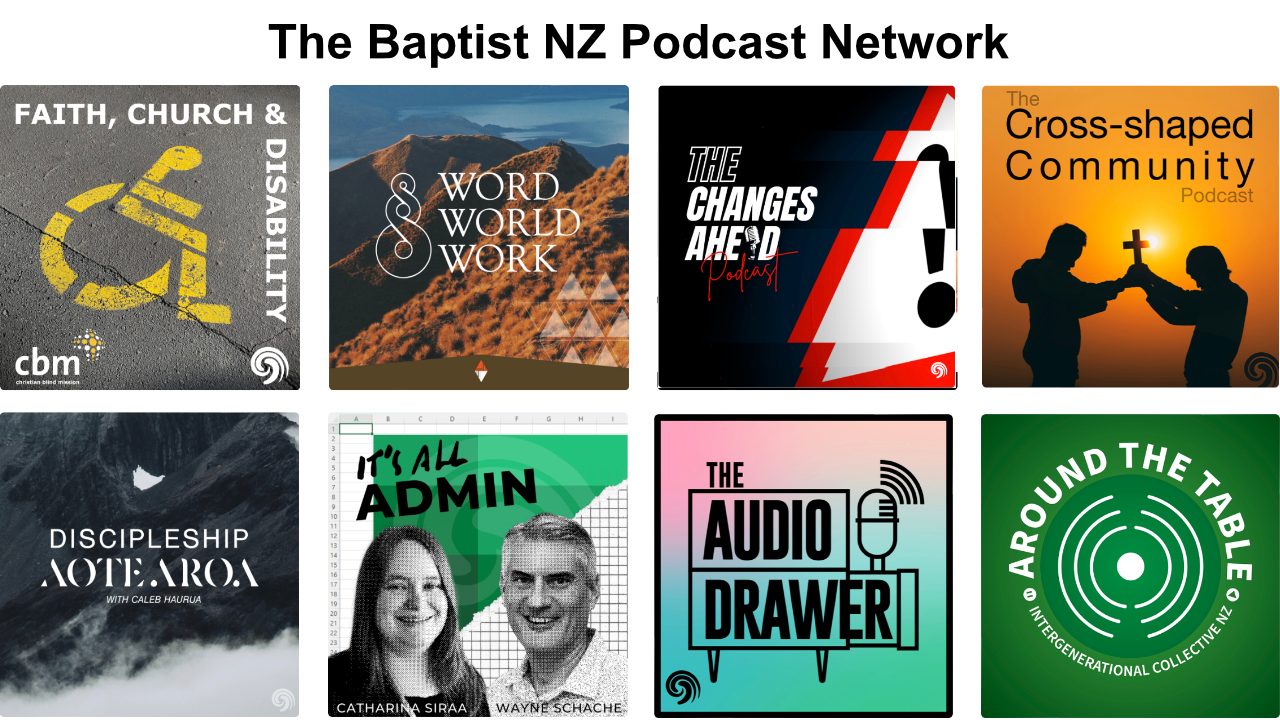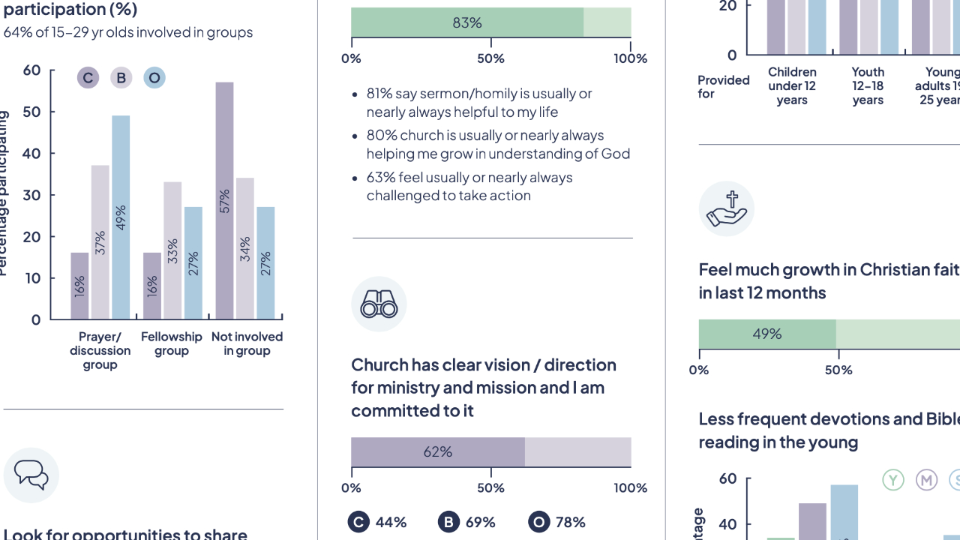
The 2023 Church Life Survey NZ is a nationwide survey every five years of church attenders. Over the last six months every church across New Zealand has been invited to take part in a 10-15 minute survey on demographics, church life, community, faith, and leadership.
This is the first of a series of articles on the Church Life Survey, where we aim to unpack this resource to help our local churches engage with the data. This article below is based on the personal response to the research that Mike Crudge was invited to present at the Auckland release of the Church Life Survey insights on 8 November 2023 at the Novotel Ellerslie. Mike is the Communications Director at the Baptist National Support Centre.
You can find PDF versions of the Church Life Survey insights booklet and highlights brochure here.
Some background
Over the last six months I have been banging on about the Church Life Survey to pastors and church administrators, encouraging as many of our 234 local Baptist churches to participate in this very useful resource that gives local churches very detailed information about the makeup and spiritual lifestyles of the people who make up that local church community. It’s a 10-15 minute survey that can be done as part of a regular church service gathering (there are two Sundays left for local churches to participate – the last one being 26 November 2023 click here to find out how to register). For Baptist churches the cost has been covered by the Baptist National Support Centre – that’s how useful we think this is for local churches!
Needless to say, I LOVE this stuff, and I think it’s so helpful for local churches.
Firstly, I want to thank the Church Life Survey team/committee – which includes a few Baptists, including the survey promotions manager: Ben Mai. The survey is administered by the Christian Research Association of NZ, in partnership with the Wilberforce Foundation and the Auckland Church Network – I am grateful for the work and support of these groups.
Response to the data
Between 8-15 November there were public events in Auckland, Wellington, Dunedin and Christchurch where the new 2023 Faith and Belief Study and the 2023 Church Life Survey report were presented by the researchers, responded to by local experts, engaged with by ecumenical panels of church leaders, as well as time for group engagement and questions. I had the privileged of responding in Auckland to the Church Life Survey data which was presented in a 24-page document called Insights from the 2023 Church Life Survey New Zealand alongside a 2-page highlights brochure - both documents are available as PDF here.
2 standout pages
I’ve got two favourite pages within this report, so my initial response will linger on them (I plan to provide additional response in future articles).
There is various research on the New Zealand church (published and in progress) that includes reflection on age distribution. In the PDF or hard copy of the Church Life Survey report, the following graph is on page 5: Age distribution by denomination
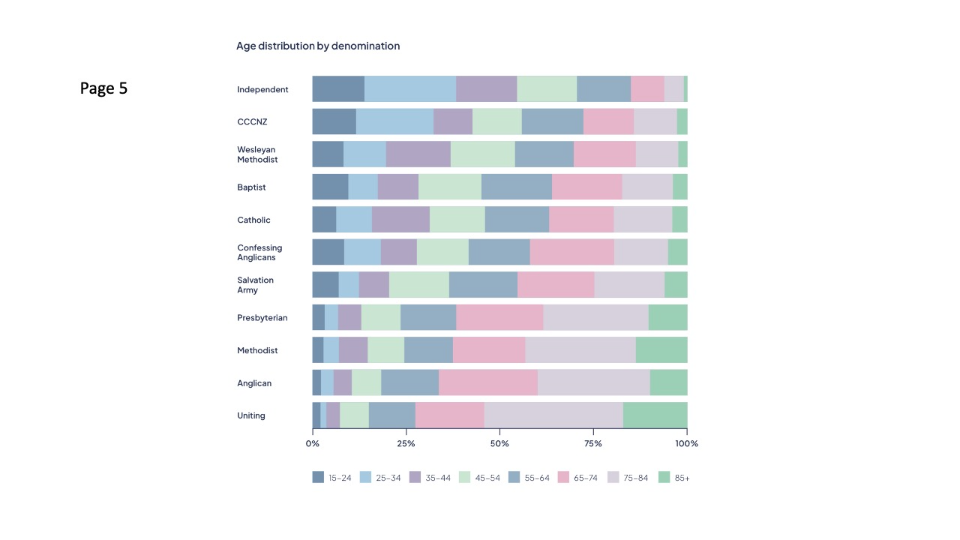
[If viewing this image on the Baptist NZ app, for a zoomable version open this article in your web browser here.]
‘Middle Aged’ is literally the 35-44 year band – double this and people live to between 70-88 years old. Highlighting this middle age band looks like this:
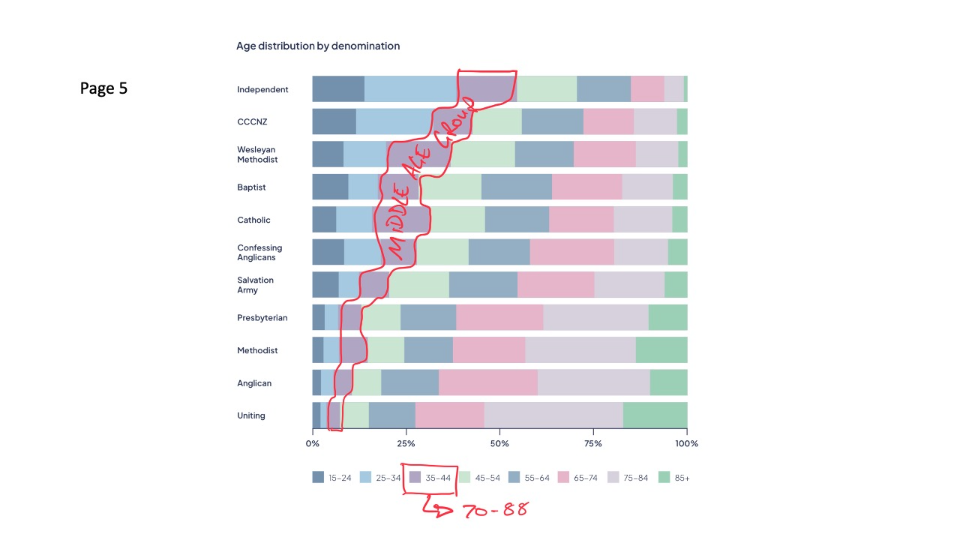
This group is technically called ‘Early Middle Age.’ This bar on the graph; it should be near the middle! So in this data set, the ‘Independent’ churches at the top are looking reasonable. Look at the rest of us! (Baptists are fourth from the top.) All of us together as the church, 38% of the church in New Zealand is 65 or older. 38%!
The definition of an aged society is one that has 20% or more of its population aged over 65.[1] Currently New Zealand’s over 65 group is about 16% and growing.
From this Church Life Survey data, I believe this is the biggest issue for the church.
The 45-64 year band can be called ‘Late middle age’ – as indicated below:
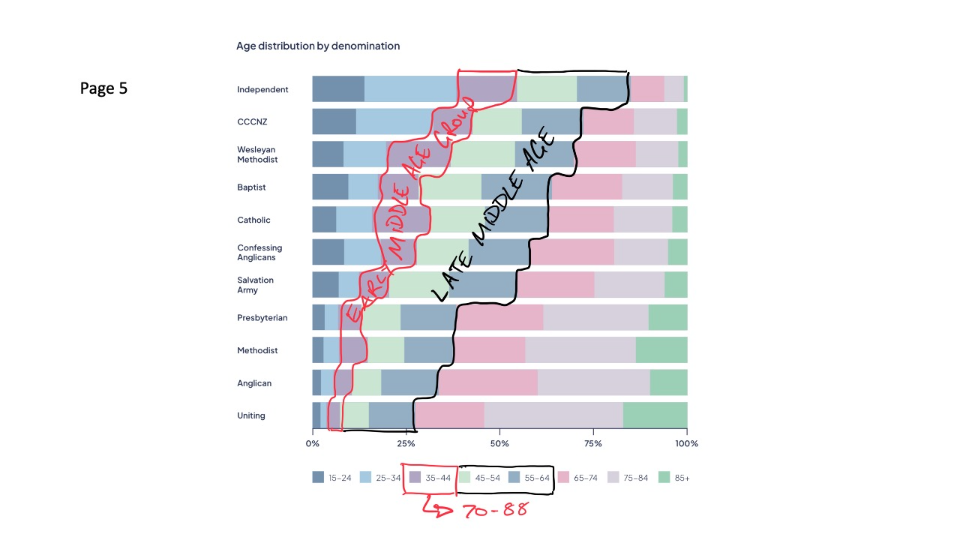
And in this next picture I’ve added actual NZ population on the top and bottom so you can compare where each church group sits alongside the general population:
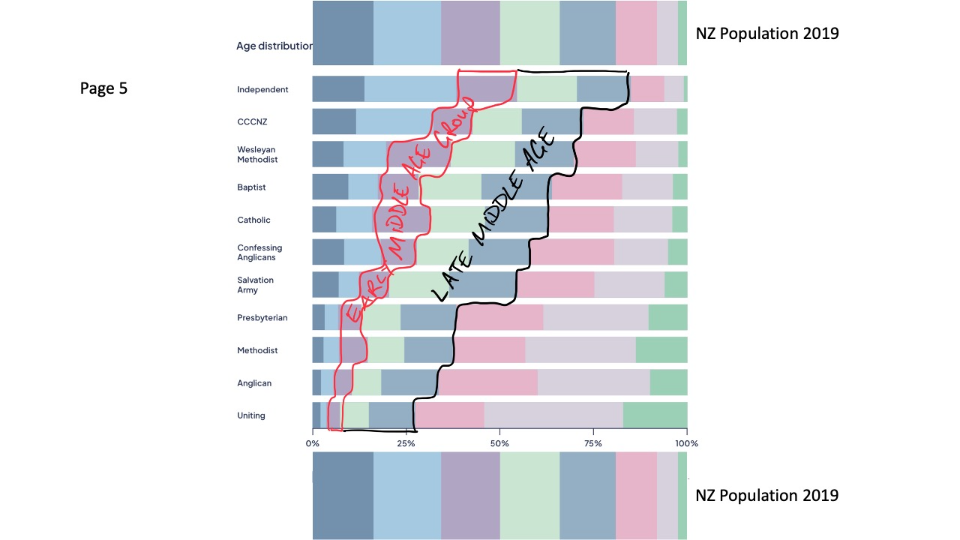
Bear in mind participants of the Church Life Survey needed to be 15 years or older, so the graphs above exclude the 0-14 age band.
I also need to mention that my expectation and ideal of a healthy local Christian-faith-community (aka church), would be a close representation of the local demographic of the context it is situated within. Therefore, broadly speaking, I think the age breakdown of our denominations should be close to that of our society.
Let this image above soak in.
It’s showing a static point in time – what I think would be amazing to see would be an animation over the last 30 or 50 years. The middle age bands would be like a wave crashing towards the left.
“Growing young”
I have a colleague, we call him a ‘Youth Catalyst’, he started this year, and he uses the phrase “growing young” (from the 2016 book: Growing Young) – he’s always talking about: “what are we doing to grow young?”
If we think of a society, or a club, or a family – that is only growing old – and losing or missing it’s young – then the everyday death that is part of life, will eventually extinguish that society, club, or family – I had a relative who had no children – when they died their part of the family tree ended – their line stopped – and that’s fine and normal.
But if New Zealand Baptists don’t grow young; our branch in the New Zealand Christian church family tree will eventually end – we don’t want that!
This data, this page of the report: calls us to listen!
Can you hear it?
These numbers are telling us its pouring. It’s not just a rainy day, this data is our Auckland Anniversary flood. It’s our Cyclone Gabrielle.
Have you read how Wikipedia describes our floods earlier this year?:
“…widespread catastrophic floods caused by heavy rainfall,”
It's not as bad as it seems
If we take onboard, that what this data shows is widespread and catastrophic, we’ve got what could be thought of as an insurance policy for such events.
You know the saying about “saving money for a rainy day?” Baptists in New Zealand have billions of dollars of asset in property. Many of the church denominations in New Zealand have this wealth – most have more than Baptists!
Imagine if rather than planning for better financial return in 20 years time – we cashed in, say, a quarter of our assets now, and spent that over the next decade into “growing young”: Basically an emergency response and recovery plan.
Good or bad stewardship?
We know the stewardship side of the Parable of the Talents in the Gospel of Matthew 25:14-30 (from a traditional interpretation).
Let’s consider this parable from the perspective of our combined church wealth: as our (the church’s) literal asset wealth gets larger and larger; we can be pleased as our financial return also gets larger. We can say: “well done, good and faithful accountants and investors…”
However, I think there is a disconnect between the severity of our problem right now, and the management of our church institutions.
The talents in the parable, when considered as money – were massive amounts of money – 1 Talent was about 20 years of income. Our billions of dollars of wealth are Christ’s possessions (or ‘capital’), entrusted with us, the church, in anticipation of us producing a spiritual ‘profit’ for Him in the kingdom of God.
It’s raining hard
This Church Life Survey data before us shows how hard it is currently raining. It shows that many of our congregations will be washed away completely in a few decades – and when that day arrives what will be left are great investment portfolios.
At this catastrophic time, I think some of our current thinking around stewardship would be seen by the Master as burying our talents in the ground.
Imagine…
What would a massive injection of our financial wealth look like if our goal was to grow young and stay the same size over the next decade? A big chunk of that graph will be dead in ten years time, so our starting plan could simply be to replace the dead with the young – as harsh as that sounds. With the kind of investment I’m suggesting, we might even grow!
That’s my first response to this data.
The second stand-out
Page 20 – is my second favourite page: What do attendees want to prioritise next year?
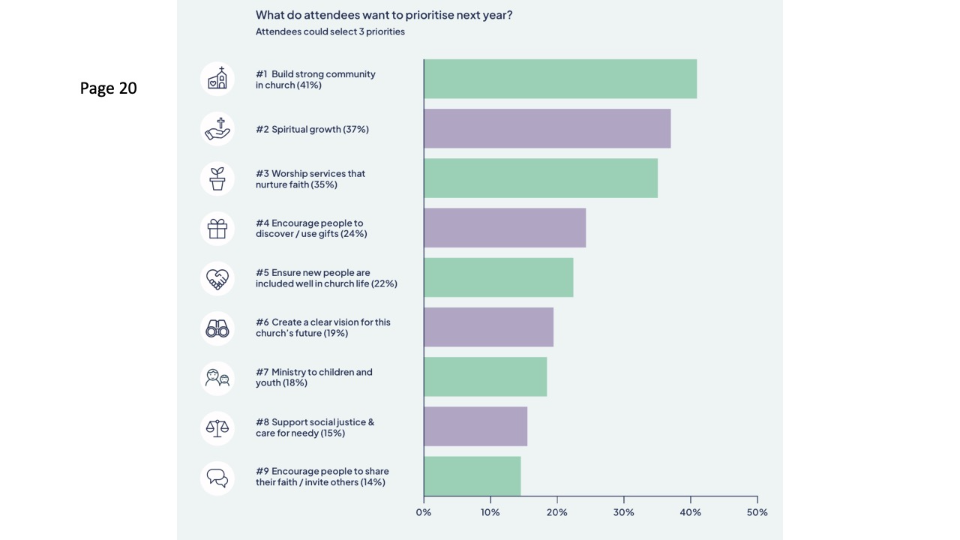
Church leaders could use this list in 2 ways
Firstly: Do more of what attendees want.
#1 Prioritise building strong community in church = good idea. (41%)
#2 Prioritise spiritual growth = excellent! (37%)
#3 Prioritise Worship services that nurture faith = imagine! (35%)
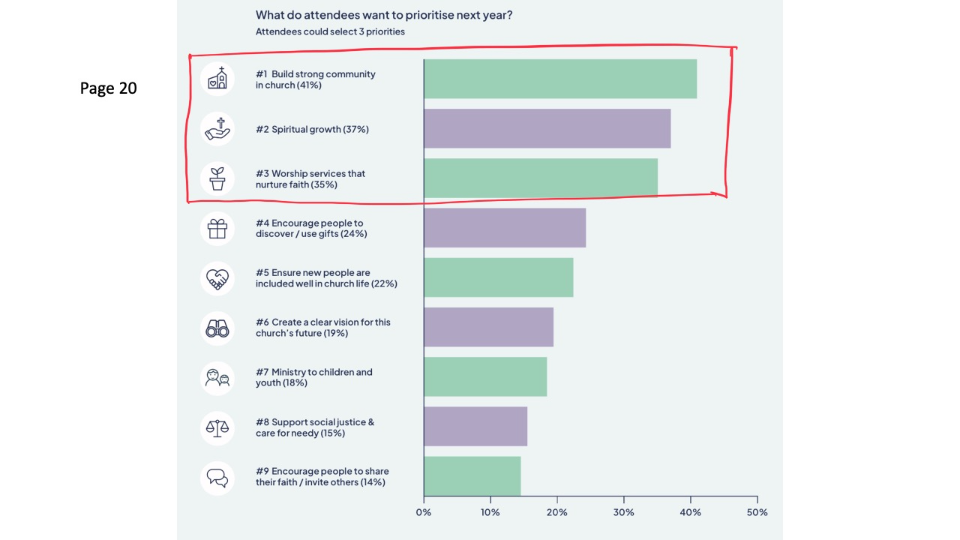
With these top 3, are church attendees saying: “this stuff is already happening, and we want more of it”? Or are they saying: “this stuff is really important, we need to lift our game in these areas”?
Half as much
This year, personally for me, I’ve made a commitment to attend Sunday church services half as much. My aim is for 50% attendance on Sundays, and I’m committing to other stuff… This is because worship services aren’t nurturing my faith. I’m not making a big deal about this, I’m just checking out half of the time on Sundays. So I could have ticked the box for #3. (I’ve written elsewhere about problems with Sunday church services as our primary expression of Christian faith, and some post-COVID-19 ideas for local churches inspired by some great questions my own local church pastor asked during lockdown… )
I think locally we need to do some specific investigation as to what these top 3 ‘priorities’ mean – look at your own specific Church Life Survey data for your local church – does your faith community have the same top 3 priorities as this national collective data? Perhaps initiate some discussion together about them – how actually might people’s priorities be realised in the next year? Or how might you subvert them as a good shepherd might lead their animals towards things they need more of?
Second use of this list
That kind of shepherding is the second way church leaders could use this list: Do more of what attendees don’t think they want.
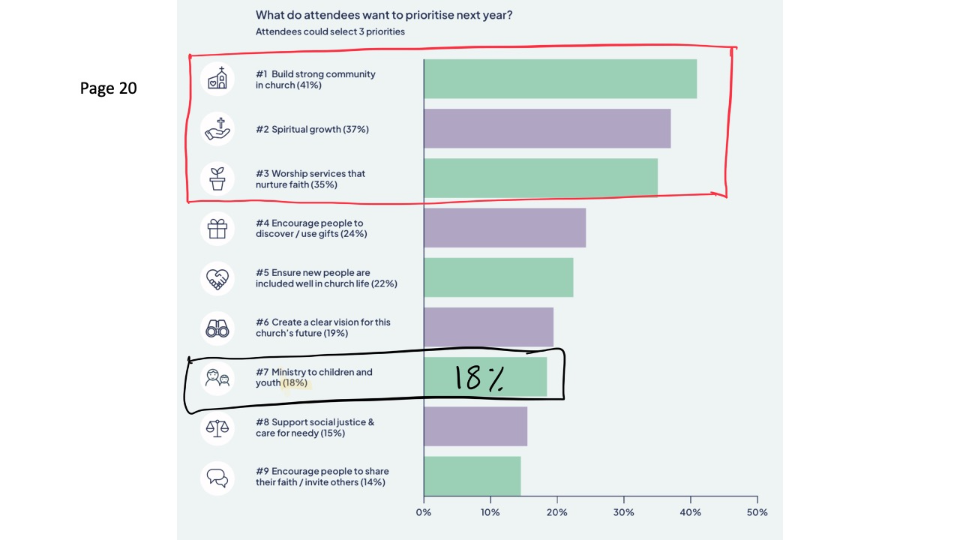
Take #7: Ministry to children and youth – only 18% see this as a priority – this is why we’re not ‘growing young’. 82% either don’t care about children and young people, or haven’t made the connection yet.
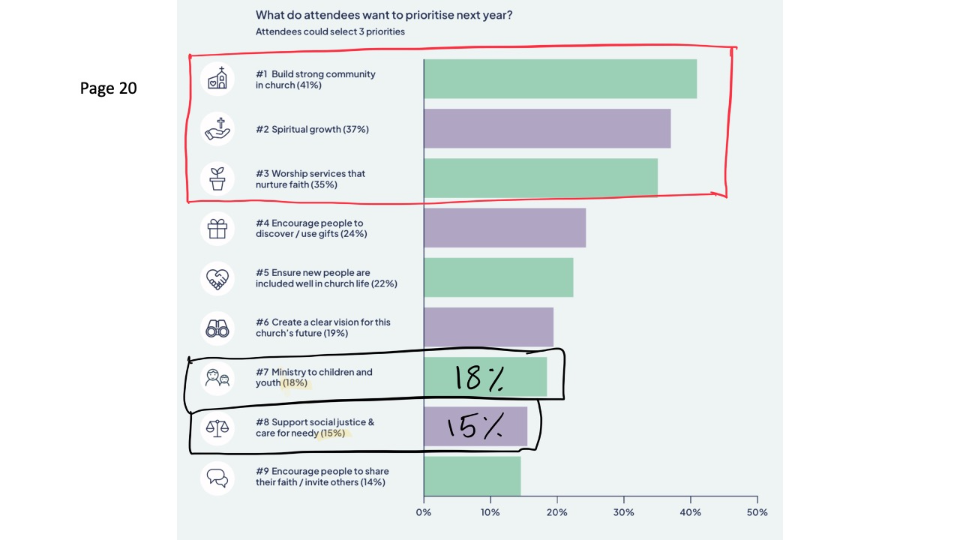
#8: Support Social justice & care for needy 85% don’t see this as a priority.
What comes to my mind with this is Luke 4:16-30 and what we call The Lukan Manifesto – when Jesus starts his ministry as we know it, by reading from the scroll of Isiah. He gives us an idea of what his mission is. And therefore an idea of what following him is to be. Jesus said:
18 “The Spirit of the Lord is upon me, because he has anointed me to bring good news to the poor. He has sent me to proclaim release to the captives and recovery of sight to the blind, to set free those who are oppressed, 19 to proclaim the year of the Lord’s favour.”
I read Priority #8 (Support social justice & care for needy) as being what Jesus came to do, and therefore what followers of Jesus are to do; but only 15% of church attenders want to prioritise this.
Are we doing so much social justice and care for the needy already, that we don’t need to prioritise this?
From this survey data, I think this is our second largest problem.
Don’t forget the voice of God
Use this list of priorities to listen to the voice of our church attendees – but alongside this; don’t forget the Old Testament prophets when they listened to the voice of God, rather than the voice of the people.
I think God’s voice is in this survey data.
2 possible actions
The decisions we, reading this, make based on what we now know from this Church Life Survey data, will be measured by the 2028 Church Life Survey in five years time, and again in the 2033 Church Life Survey in a decade.
This data helps me to imagine at least 2 possible actions – from people like you reading this today:
1. We might do nothing differently – this data is nice to know.
2. We might latch on to a few priorities that this data highlights, and pivot significantly because of it.
------------------------------------------------------------------------
Notes:
[1] Paul Spoonley, The New New Zealand: Facing demographic disruption (2020).
Mike Crudge reflects occasionally on issues to do with Church, Society and Communication at mikecrudge.com
Images: from the Church Life Survey NZ 2023 report as used on Mike’s PowerPoint slides on 8 November 2023.
ADVERTISMENT
The Baptist NZ Podcast Network: more than 90 episodes of great content:
